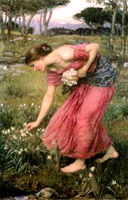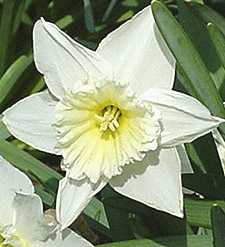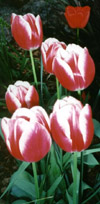|
Biogardener Homepage with links to my other websites
Getting Started Organically
Edible Organic Garden
Trees & Shrubs
Environmental Issues
Meet Traute Klein
Healing Hug
Allergy Lifeline
Sunny Manitoba
Born to Be Creative
Theirs Is the Kingdom
Heritage German
Biogardener Guestbook or Read Entries  Send me your own organic gardening story. Email me by clicking on the mailbox graphic. Send me your own organic gardening story. Email me by clicking on the mailbox graphic.

Related Articles
What Are You Doing to My Beautiful Creation?
Floral Cuisine

Amazon BooksColor for Adventurous Gardeners
Succession Planting for Year-round Pleasure
Edible & Medicinal Weed

|
Deadly Spring Beautyby Traute Klein, biogardenerSpring flowers display the most beautiful assortment of colors. Most of them are poisonous to protect them from being eaten by animals. Enjoy them in the great outdoors but do not bring them into the house where they will make people sick.
Spring, Season of New LifeEver since my family came to Canada in 1952, I have been hit with homesickness for my homeland every spring 1953, every spring except one, that is, and that was the one which I spent in Vancouver, BC, where the climate and flora mirror those of central Europe. The other springs I spent in various places in the Canadian prairies where the continental climate offers neither spring nor autumn, just winter and summer, joined by a few of weeks of transition where the weather switches back and forth between the two extremes. Spring is my favorite time when the earth bursts forth with new life after a well-deserved rest. I look for signs of life long before the calendar proclaims the new season: a bird returning from the south, a flowering bulb pushing its tip through the snow, a blade of green grass on a brown lawn.
Bulbs, Harbingers of Life
In the Canadian prairies, the blue scilla (Scilla siberica) is the first touch of color to grace our gardens. In Winnipeg, that does not happen until April.
Bulbs, Symbols of Spring
Bulbs are among the most beautiful of flowers. Their brilliant colors are favorite subjects of watercolorists, including me. Seeing that those plants are the first to grace the earth, it would seem logical that animals would find them delicious after the long winter? That, however, is not the case, and why not? Simple. They are poisonous. Most references do not support this claim, but my experience does.
Don't Eat Bulbs I will try anything once. Looking at the juicy seedpod of a tulip (Tulipa) as I pinched it off after blooming, I considered it a shame to waste it. So I ate it. Well, I won't eat a second one. It gave me the worst sore, burning throat of my life.
I have heard that in wartime the Dutch people have dug up their tulip bulbs and eaten them. Maybe the bulb is not as bad as the seedpod, or maybe cooking extracts the ingredients which attacked my throat. I don't think that I want to test the theory, though. The bulbs are much too expensive anyway. I have known all my life that blooming hyacinths should not be kept in the house, as their strong perfume will give people headaches. All parts of the plant are poisonous. The scilla is also a member of the hyacinth family and the shape and arrangement of the flowers verifies this. It does not emit a perfume, but I am not going to test it out. I certainly have never seen an animal investigating the plant, and I have lots of them blooming all over my garden right now. The daffodil (Narcissus) is recognized as poisonous by all references. It is astringent and strongly emetic, i.e. causing vomiting. Cut daffodils should not be added to flower arrangements, as the poison released in the water will cause the other flowers to wilt quickly.
The white narcissus with the short bell does have a strong perfume, but it is not hardy where I live, and I do not remember from my childhood if the perfume has an adverse effect on people.
Primulas
In my youth, every Sunday afternoon saw a group of friends head into the hills around our city on bicycles. Careful with primulas. Touching them causes skin rashes, so they, too, are poisonous.
Lily of the Valley
One of the most gorgeous and most fragrant flower is also one of the most indestructible. With few exceptions, I avoid harmful plants in my garden. Lily of the valley is one of those exceptions. It is simply too beautiful not to have around. I just make sure that it is hidden from the view and reach of children, and I am not the least worried about pets. They are much too smart to touch a poisonous plant.
Lily, Symbol of Life or Death?
Careful with lilies. Remember that they are very poisonous. I do not go to church on Easter Day, because the smell makes me sick, and I avoid entering the building for a couple of days after the lilies are removed, because the effects can be felt until after a complete air change. Here are some reactions to white lilies which I have observed in people:
The impact of the poison can be lessened by taking pointed scissors and cutting off the stamens from the flowers as soon as they open. Don't touch the pollen but wrap it in tissue paper and flush it down the toilet. If any of the pollen has fallen off the stamens and is clinging to the interior of the flower, wipe it off with a wet Q-tip. Better still, don't buy lilies. In North America, the white lily appears to be the symbol of life and is therefore displayed at Easter time. In Europe, I have never seen this flower anywhere except in cemeteries where it was probably meant to have the same symbolic meaning, but to me it has become a symbol of death, which is not surprising considering what effect it has on me.
Symbol of Resurrection
|
The material on this site may be reproduced or republished only by special arrangement with the webmaster.
You are, however, welcome to pass on or link the URL.